
The fifth black Dan Armstrong guitar is currently owned by Chris Stanco who has one that had been modified with a
black scratchplate and headstock veneer that features a thin strip of white around the outer edge of the black
material giving the instrument the look somewhat reminiscent of the Dan Armstrong 'London' series instruments as they
too featured scratchplates and headstocks in nearly this same exact color (though the London models used aluminum).
All photos on this page are courtesy of Mr. Chris Stanco.
As can be seen at upper left, the body has also been modified to support a Tunomatic style bridge
while at right a 'string-thru body' design has been added - similar to
Stratocaster & Telecaster guitars. At upper left, the 'string-thru body'
alteration can be seen.
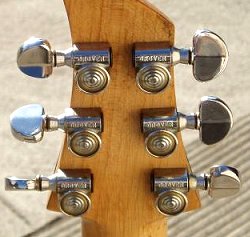
|
Unusual to this instrument is the fact that it is equipped with some different looking Grover
tuners. While it is by no means unusual to see them on a Dan Armstrong instrument, it is, however, unusual to see
them on an earlier instrument such as this as according to Dan it was later when he switched over to using the
Grover line of tuners. Furthermore, when he did switch, it was to a Grover Rotomatic set that was
smooth on the back and had the letters 'Pat. Pend. U.S.A.' stamped into it. This continued until later in 1970 when
the patent was granted and the stamped in lettering ceased. Then the Grover Rotomatic tuners that Dan used featured a
smooth chrome backing with no lettering stamped in at all.
|
Since these instruments were normally equipped with Schaller tuners and, since the early Schaller
tuners featured their setting screws on the bottom of the tuner (like the Grovers), it seems highly likely that the
past owner simply swapped out the stock Schallers for a decorative set of Grovers.
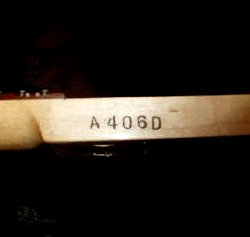
|
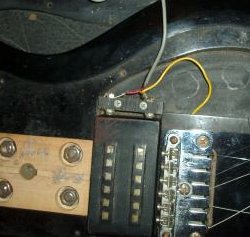
|
At left, the serial number of the neck corresponds with the time frame of the instrument. At right, notice again
the extra block of butyrate (secured to the inside of the cavity with screws) housing the banana type plugs. Notice
the tongue of the neck - in particular, two erased markings, as though something at one time was pencilled in and then
later erased. Usually the serial number stamped in the side of the tongue is pencilled in on top of these necks
(due to the fact that the butyrate is not transparent) - so one of the markings could be the serial number. The other
would be unknown.
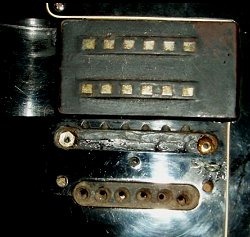
|
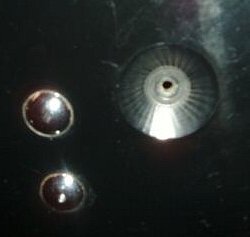
|
Upper left, with the bridge/tailpiece removed, once can see the routing and screws holes for the tuno-matic style
bridge as well as the holes for the string-thru body design. At right, the tooling of the butyrate material can be
easily seen in the pickups' set screws cavity/hole. According to Chris Stanco, the instrument also has two small
bumps or 'dimples' on the backside just like Chad Coulters guitar.
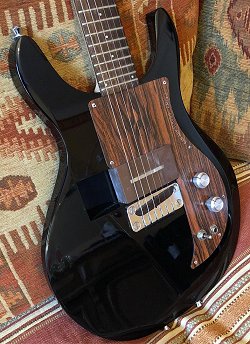
|
An unknown black plastic Dan Armstrong · Ampeg prototype guitar in beautiful condition. This same instrument can be seen on the
next page accompanied by a matching black bass.
Notice the reflection of the volume and bass controls as they shine on the smooth, glossy scratchplate that these early models were equipped with.
In the enlarged view, even the switch has a reflection, although it's small as the scratchplate comes to an end near it. Also in the enlarged view
one can make out an RB, (Rock Bass) pickup that is in use. Notice too, the straight headed screws used to anchor the tailpiece to the body. Photo
courtesy of Didier Colombi.
|
continue
menu
Names and images are TMand © Dan Armstrong / Ampeg. All rights reserved.
All other names and images are TMand © of their respective owners. All rights reserved.
|
| |

